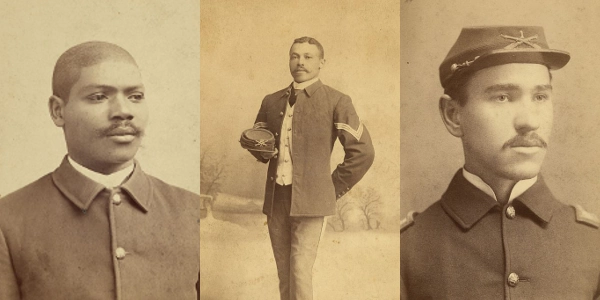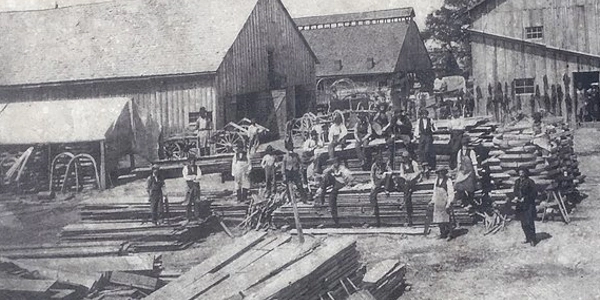Image above: Fort Ticonderoga, C.E. Peterson, Historic American Buildings Survey. Courtesy Library of Congress.
Spotlight on Lesser Known History
Fort Ticonderoga, New York
America's Best History Spotlight
On this page we're going to Spotlight the lesser known historic sites and attractions that dot the history landscape across the USA and are worth a visit if you're in their area. And while they may be lesser known, some are very unique, and will be that rare find. You'll be, at times, on the ground floor, or maybe even know something others don't. It'll be fun. Visit them.
Fort Ticonderoga, New York
It's a site that was important for trade, situated between Lake George and Lake Champlain along the La Chute River. The French understood that, and built Fort Carillon, its original name, in October 1755, to protect just that, one year into the French and Indian War after the Battle of Lake George. The star-shaped fort would be overlooked by the heights of Mount Defiance behind it and take three years to build. The area had been known by Europeans since Samuel de Champlain's founding in 1609. Since 1691, it had been a contested area between the French, British, and area tribes, including the Iroquois.
Two battles of the French and Indian War were fought there, the Battle of Carillon in 1758, and the Battle of Fort Ticonderoga in 1759. But the French and Indian War was not the only conflict that used the fort as a site. In the American Revolution, on May 10, 1775, the Green Mountain Boys would attack the British outpost. Today, after falling into disrepair in the early decades of the 20th century, you can visit the extraordinary fort, history, and tours of a day within its living history of 1774, and learn about all of those. Image above: Drawing of Fort Ticonderoga and its lines from South Day, 1759. Courtesy Library of Congress.
Sponsor this page for $100 per year. Your banner or text ad can fill the space above.
Click here to Sponsor the page and how to reserve your ad.
Info, What's There Now, History Nearby
Fort Ticonderoga, New York
Yes, it's now known by its British name. The reconstructed fort sits on two thousand acres with trails that lead to the Battle of Carillon and elsewhere. There's tours to take of the fort, even boat tours on the lake, and a day or two of resplendent historic fun.
When constructed by the French, it was meant to prevent British military access to Lake Champlain, but that only worked for one year, despite walls fourteen feet thick and seven feet high. There was a dry moat five feet deep around it, three barracks and four storehouses inside, plus a powder magazine. Part of the reason it was not considered hard to defeat were the heights of Mount Defiance behind it and its position too far west of the lake.
Image above: Fort Ticonderoga, 2009, Chamy. Courtesy Wikipedia Commons. Below: Capture of Fort Ticonderoga in 1775, 1875, Heppenheimer and Maurer. Courtesy New York Public Library via Wikipedia Commons.
Where Is It
Fort Ticonderga is located on the shores of Lake Champlain at 102 Fort Ti Road in Ticonderoga, New York, 12883. It is two hours from Albany, just over one hundred miles, and five hours from New York City off Exit 28 of Interstate 87, then NY-74 E.
What is There Now
Today, Fort Ticonderga is a fully restored and reconstructed historic site on two thousand acres that tells the story of the construction, battles, and other history that makes the former French, British, and American fort famous. Over 75,000 visitors per year visit the fort to immerse themselves in the stories held within the walls. There are tours, exhibits, a gift shop, and more of the fort, and most years, Mount Defiance, and boat tours. There is also food available at the Fort Cafe'.
When Open and How Much
Spring to mid-October. Check the website for the specific dates of the year.
A day pass is $19.95 for adults and $12.00 for children 5-15. Under 5 free. A one day pass is also good for a free next day. There are specialty tours available for an additional fee. The fort is usually closed on Mondays.
Fees subject to change.
Websites
Fort Ticonderoga
History Nearby
This area of New York has history and nature replete at every turn, including all those vistas of the Adirondacks, Lake George, and Lake Champlain. To your east, there's also White Mountain National Forest in Vermont, and southeast the historic sites around and within Boston. On your way up from Albany, there's also Saragota National Historic Park and the sites of the Hudson River Valley National Heritage Area. Just south, there's also the unique Mohonk Mountain House.
Buy Chronology

Great Book for the History Fan with Fifty Short Essays Telling the Story of American History.
Photos, History, and More Spotlights
French and Indian War
Battle of Carillon - The British saw the import of the French fort and began to plan an attack to remove its strategic location, not only for defense, but as a launching pad for other attacks. On July 8, 1758, British General James Abercromby ordered a frontal attack against the frontal defenses away from the fort with sixteen thousand men. The four thousand soldiers of Fort Carillon defeated them.
Battle of Fort Ticonderoga - During the winter of 1758-9, French forces were reduced to four hundred, prompting the British to attack again. On July 26, 1759, British General Jeffery Amherst attacked with eleven thousand troops and cannons drawn within six hundred feet of its walls. The French were defeated over two days, but did what they could to destroy the fort.
Image above: Fort Ticonderoga, C.E. Peterson, Historic American Buildings Survey. Courtesy Library of Congress.
American Revolution
Capture of Fort Ticonderoga - At the start of the American Revolution, the British were still using the fort, but mostly as a supply depot garrisoned by only forty-eight men. On May 10, 1775, just one month after the battles of Lexington and Concord, a surprise attack by the Green Mountain Boys and militia under Ethan Allan and Benedict Arnold forced the fort to surrender. The cannons gained by the forces of the Continental Army would be used to break the siege at Boston.
American control of Fort Ticonderoga would last until July 5, 1777, when it was abandoned under threat of British cannon on Mount Defiance. In September of that year, American forces attempted to recapture the fort, but were unsuccessful. It would be predominantly destroyed by the British when they withdrew from the fort in November 1777, and the area abandoned for good in 1781.
Photo above: The Pavilion, built 1826 outside the walls of Fort Ticonderoga on the edge of the King's Garden, circa 1900/1920, Tomlin Art Company. Courtesy Library of Congress.
Restoration
The property began to serve as a tourist attraction in 1785, and was sold to horticulturist William Ferris Pell in 1820. He built the pavilion, first as a summer retreat, then later with use as a hotel. In 1909, an architect was hired by the Pell family to restore the fort. The historic site was opened to the public, its opening ceremonies attended by President Taft.
The Fort Ticonderoga Association was started in 1931 and has run the historic site since that date. They have continued to restore the fort, bought the land surrounding it, and interpret its importance through living history and tours.
Photo above: Ruins of Fort Ticonderoga, 1923, Keystone View Company. Courtesy Library of Congress.

T-Shirts and Gifts from the official souvenirs of Americasbesthistory.com.
About
America's Best History where we take a look at the timeline of American History and the historic sites and national parks that hold that history within their lands.
Photos courtesy of the Library of Congress, National Archives, National Park Service, americasbesthistory.com and its licensors.


